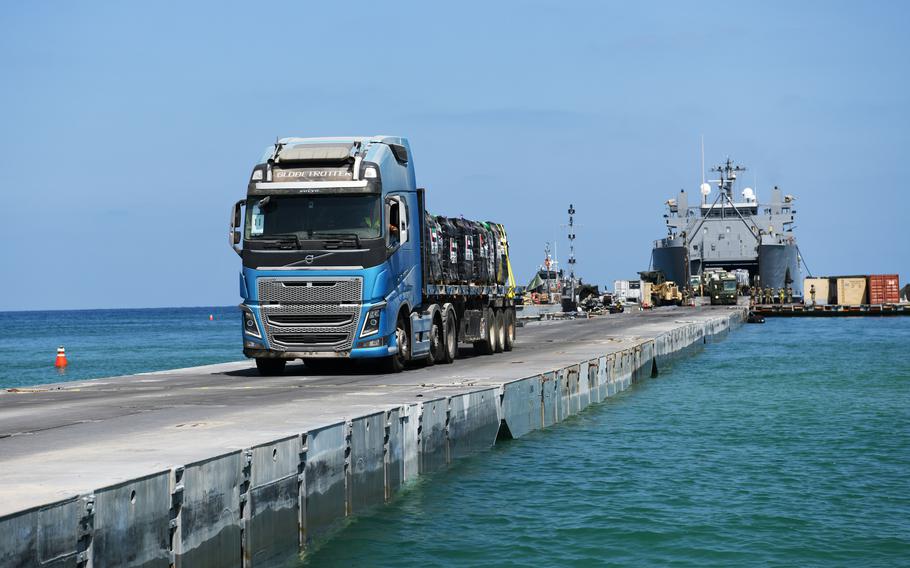
A driver contracted by the Defense Department transports humanitarian aid from an Army vessel across a floating pier and onto the beach in Gaza in June 2024. The temporary pier, part of the Joint Logistics Over-the-Shore capability, enabled maritime delivery of international aid to war-torn Gaza. (Jordan Kirk-Johnson/U.S. Navy)
WASHINGTON — Army and Navy units who worked on the U.S. military’s humanitarian effort to move supplies into Gaza using a floating pier were ill-equipped, undermanned and lacked training for the mission, the Pentagon’s inspector general has concluded.
The report, which was dated Friday, pointed to a breakdown in joint training and years of divestment in mission-essential watercraft.
“The [Defense Department] repeatedly encountered challenges and inefficiencies during [Joint Logistics Over-the-Shore] operations and exercises, including during Operation Neptune Solace in Gaza,” according to the IG report.
Operation Neptune Solace, which spanned from March 2024 to July 2024, was an Army-Navy mission to build a temporary pier to funnel humanitarian aid into Gaza after Israeli forces launched a military campaign into the enclave in response to the October 2023 surprise attack on Israel by Hamas militants. As the war raged, world health officials warned millions of Gazans were facing extreme hunger as Israel retaliated against Hamas.
The purpose of the pier was to deliver aid without putting U.S. troops in harm’s way in the war-torn region. But the mission was hampered by bad weather and logistical issues that resulted in the loss or damaging of vessels and equipment and numerous personnel injuries, including the death of one soldier.
The Navy reported 27 watercraft and equipment were damaged during the Gaza mission, totaling approximately $31 million in repairs and maintenance costs, according to the report. U.S. Central Command, which oversees military operations in the Middle East, reported 62 injuries among U.S. personnel supporting the mission, though the inspector general was unable to determine whether the injuries occurred while on-duty, off-duty or due to pre-existing health conditions. The report did not say whether the 62 injured includes service members and Defense Department contractors.
The mission was short lived. The pier became operational May 14, 2024, but just two weeks after it was in service, officials were forced to suspend operations and remove the pier from the shore to repair damage caused by rough weather. The pier again was removed from the Gaza shore at the end of June due to bad weather and was kept at the Israeli port of Ashdod for weeks when officials announced July 17 that the operation was ending.
The Pentagon’s inspector general was directed in late June by the Senate Armed Services Committee to review the Gaza pier mission. The report concluded the Army and Navy did not meet service-level standards for equipment and unit readiness to perform JLOTS operations.
“We identified that the Army and Navy faced low equipment mission-capable rates and low manning and training levels,” the report reads.
While the number of personnel assigned to the joint units was redacted, the report found the Army and Navy struggled to staff the ships for the Gaza mission, which delayed the deployment of some watercraft.
“[Navy Beach Group One] had to pull together every person they could to sufficiently staff vessels in accordance with Navy requirements,” the report reads.
It also found the Army and Navy did not organize, train and equip to a common joint standard for JLOTS operations and exercises. This was due, in part, to U.S. Transportation Command not establishing joint mission standards, minimum planning standards and requirements for the services and their equipment to work together. TRANSCOM, which oversees and coordinates the Defense Department’s logistics distribution efforts, is responsible for planning JLOTS training and operations.
“USTRANSCOM officials identified communications challenges as early as six years before Operation Neptune Solace,” the IG report reads, referencing exercise reports from 2018.
From 2014-2024, the Defense Department conducted one JLOTS operation and 11 JLOTS exercises. Four of the 11 exercises identified problems with the vessel or equipment maintenance, readiness or availability.
A 2020 review specifically noted watercraft maintenance shortfalls and identified the need for the Army and Navy to address reductions of JLOTS-capable equipment and personnel across the Defense Department. Additionally, seven of the 11 JLOTS exercises identified problems with communication. These challenges included a lack of shared knowledge between the Army and Navy participants, gaps in their systems integration, and the need for a common operating view.
In recent years, the services divested in JLOTS-capable units and equipment. In 2023, the Navy decommissioned one of its two JLOTS-capable units and deactivated the Elevated Causeway System, a JLOTS system that provided the Navy with the capability to construct a more weather-resistant pier.
Additionally, the Army sold about 48% of its watercraft between 2018 and 2019. Reducing the Army’s JLOTS watercraft took it from a force of 134 boats down to 70 boats.
“Officials from headquarters, Department of the Army logistics directorate and the Navy’s Office of the Deputy Chief of Naval Operations for Fleet Readiness and Logistics, the [Army’s 7th Transportation Brigade], [Navy Beach Group One] and [Navy Beach Group Two] expressed concern at the services’ divestment of JLOTS capabilities and stated their belief that the DoD’s current JLOTS capabilities were not sufficient to meet projected needs,” the report reads.
The inspector general made three recommendations, including the Army and Navy review watercraft units and determine improvements to force structure, training, and equipment acquisition and maintenance. It was also recommended TRANSCOM develop and implement a plan to meet its JLOTS responsibilities.